Part 1/5: “Pa’lante”: Puerto Rican Resilience After Maria
Published: September 21, 2019
By Bobby Bascomb
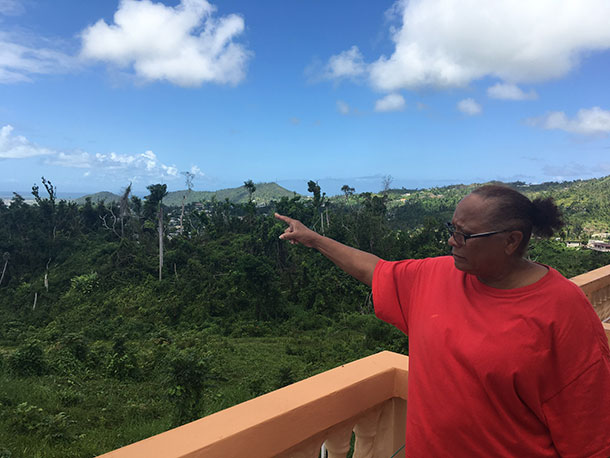
Gloria Vasquez points towards the broken and battered trees behind her house. (Photo: Bobby Bascomb)
(stream/download) as an MP3 file
Hurricane Maria made landfall on Puerto Rico on September 20, 2017, taking roughly 3,000 lives. Many died not from the storm itself but from morbidity linked to such causes as treatable infections, unsafe water and accidental electrocution. But as Living on Earth’s Bobby Bascomb reports, some communities are looking at Hurricane Maria as a call to be more resilient the next time around.
BASCOMB: Hi, and welcome to this Living on Earth special feature. I’m Bobby Bascomb, Managing Producer of the show. Hurricane Maria made landfall in Puerto Rico in September of 2017, and left a trail of devastation in the wake of its 165-mph winds. I traveled to the island nine months after the storm to learn more about how Puerto Rico was recovering. I filed a series of stories about the devastation and slow government response that followed, but I also found a renewed sense of community and resilience among the Puerto Rican people. For this special feature I’m joined by Adnelly Marichal, a Puerto Rican documentarian who lived through the storm.
So Adnelly, can you tell us a little bit about your own personal history with Puerto Rico?
MARICHAL: So my parents were born and raised in Puerto Rico. And when my mother was in college, she got an opportunity to come stateside and study her masters in Connecticut. And then my dad joined her and they just ended up staying there and raising my sister and I over there, but the rest of our family was still in Puerto Rico. So I grew up going back and forth many times a year to visit all of our family.
BASCOMB: And now you're living there full time.
MARICHAL: Yes, I'm living there full time. So in the spring of 2017, I decided that I wanted to pursue some documentary work in Puerto Rico. I've basically lived my whole adult life in New York City. And again, still coming back and forth from Puerto Rico on a pretty regular basis. And kind of on a whim. I was like, you know, what would it be like to actually live there as an adult? Just what is it like to actually live there and not be on vacation? So I moved there in early September 2017, right before the storms hit.
BASCOMB: That was some timing.
MARICHAL: Literally, my plane came in the night before Irma hit. And it was, I'd say there was like five people on the plane.
BASCOMB: Oh, my gosh.
MARICHAL: Yeah.
BASCOMB: And then Maria hit one week after Irma, almost exactly one week. Exactly.
MARICHAL: Yeah. So it was kind of one after another. But I was Yeah, I was actually really happy to be there. Just so I could help my parents in whatever way I could. There was like a lot of preparations that we had to do and a lot of running around. We couldn't find the proper screws put the hurricane shutters on we went to all these stores, like just it was kind of chaotic.
BASCOMB: Yeah, yeah. It sounds really chaotic. And how was it for you to live through the storm? I mean, what a rude, welcoming, in some sense.
MARICHAL: Yeah. I mean, it was definitely not something I was planning on. But I would say it was, it was scary. For sure. I'm sure most people would say that. But just because I had never been through such a powerful hurricane. I mean, I'd gone through Sandy in New York, and that was definitely a pretty devastating hurricane as well. But everyone said this was going to be the biggest hurricane that had ever passed through the island. So no one really knew what to expect. So I think not knowing was one of the scariest parts while it was happening, you know, you're in your house. It’s totally dark, because of all the hurricane shutters. And so you just don't know what's going on outside. And I think that that's one of the scariest parts, or at least that was one of the scariest parts for me, not knowing what was happening outside. Hearing, you know, terrifying sounds and also not knowing when it was going to be over. And what what was happening? And of course, yeah, we lost power, you know, like the night before it even started hitting. So just feeling cut off is scary.
BASCOMB: Right. So you mentioned this a little bit, though, about living through the storm. But your parents were there with you? Did you have pets? And how did you guys pass the time?
MARICHAL: We don't have any pets. But basically, the time was passed running from one corner of the house to the next because there was a lot of water coming in. So we were just kind of running around, trying to mop up water, putting towels down, making sure all the the shutters were in place. It was just like even inside the house. It was it wasn't nearly as chaotic inside, but it felt like the whole time, it was just trying to make sure that everything was as safe as it could be. And they went by pretty fast. It was definitely a nerve wracking time for sure. But I just remember the whole time just running around trying to deal with some flooding going on. For me personally, I feel like my family was very lucky. We didn't go through that much damage to our home. But I noticed for months afterwards, I had nightmares about the storm, which was something I was not expecting at all. And I realized that I was processing it.
BASCOMB: Yeah. What were you dreaming if I may ask?
MARICHAL: I was dreaming that these stress dreams where I was basically going through my like hurricane related tasks. So just running around from one corner of the house to the other corner of the house and just feeling like I had to move faster and get things done. And like knowing that something bad was happening. Like I just kept having this reoccurring stress dream that I just couldn't finish my tasks fast enough.
BASCOMB: Gosh, that sounds awful. So it's like, you know, the storm is over. But the stress of it continues?
MARICHAL: Oh, definitely. Sure, sure. And again, like I feel like I had a very lucky experience. So that's why I was surprised when I realized that I was having to deal with some emotional processing.
BASCOMB: Well, your experience sounds a lot like the experience of Christina Nieves, one of the characters in the story that we're about to play. She also moved back to Puerto Rico right before the storm hit and had a similar experience living through this really devastating event.
MARICHAL: Yeah, her experience that is next next level, like, I can't even imagine that it was scary for us. But that was definitely a next level experience. We were really fortunate that that we did not experience that type of damage.
BASCOMB: Yeah. So the story that we're about to hear, I actually didn't set out to do the story that I ended up with, I started out to do a story about micro grids, the solar panel company that I originally reached out to they said, Oh, you have to talk to this community organizer, Christina Nieves she'll be there. And they set me up with a time to go and speak with her. And I got there and I realized this isn't a story about solar panels anymore. This is about people's personal lives, you know, living through this devastation of the storms. So let me go ahead and play this for you.
[DRIVING SOUNDS, GPS DIRECTIONS ‘IN HALF A MILE…’]
BASCOMB: To get to Humacao, Puerto Rico you can take highway 53, past McDonalds, grocery stores, and car dealerships. Except for the palm trees, it feels like you could be anywhere in the US. But turn up the narrow, twisty mountain road toward Humacao and it’s a different story. Electrical poles stick out of the ground at awkward angles. Electrical wires hang casually over the road, swaying in a light breeze.
NIEVES: There’s a lot of posts that look like they’re about to fall on people. Trees near highways that look like they are about to fall on cars. And that actually happened.
BASCOMB: Christine Nieves is director of Proyecto Apoyo Mutuo, the Mutual Aid Project, based in a community center at the very top of the mountain in Humacao. Christine says downed power lines and unstable trees are now common here.
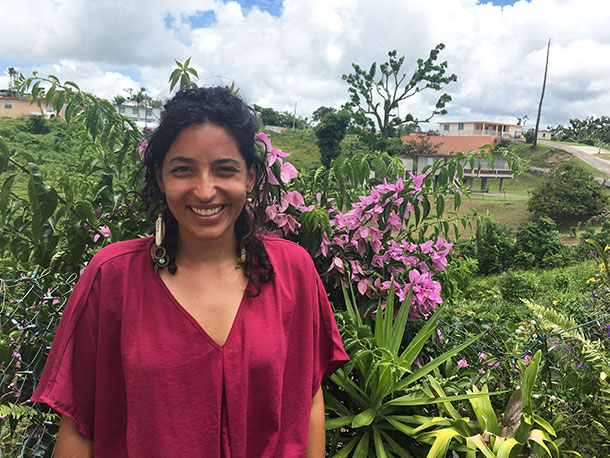
Christine Nieves is director of Proyecto Apoyo Mutuo, the Mutual Aid Project, founded after Hurricane Maria to help her community recover from the storm. (Photo: Bobby Bascomb)
NIEVES: There was a tragedy not too long ago of a young man dying from having a tree collapse on top of him. So you’re still seeing that.
BASCOMB: Christine is petit with wavy black hair and a bright smile. She wears a flowy pink top and long earrings. She left Puerto Rico to go to college at Penn State and then got her master’s degree at Oxford in England. She came back to Puerto Rico 6 months before Maria hit the island and settled here in Humacao, where the hurricane actually made landfall.
[WALKING SOUNDS]
BASCOMB: Christine leads the way across a large parking lot to the edge of the mountain and points to a wide green valley below us.
NIEVES: So this is where the eye of the hurricane entered.
BASCOMB: Through this valley?
NIEVES: Yes. It actually made landfall first in this community and all of these mountains.
BASCOMB: Just to describe this area where we are. So right there is the ocean, so that’s obviously where the hurricane came in and just traveled up this little valley in between us here, between the mountain that we’re standing on and that mountain over there and hit these homes right in front of us.
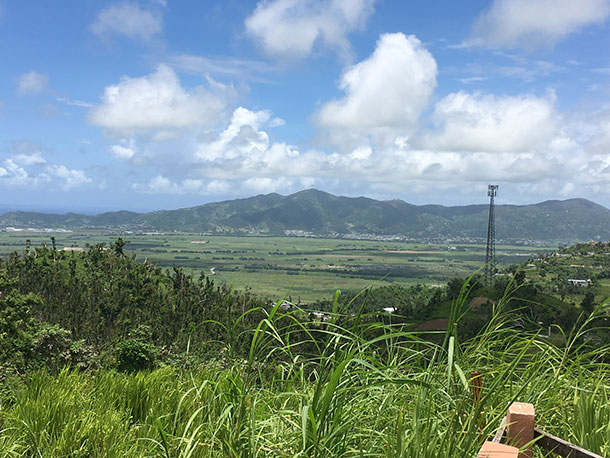
Hurricane Maria travelled up this wide green valley to the interior of Puerto Rico. (Photo: Bobby Bascomb)
NIEVES: Mmhm, absolutely.
BASCOMB: Were you here during the hurricane?
NIEVES: I was, yeah. My house is actually not too far from here.
BASCOMB: So what did it feel like?
NIEVES: It was chaotic. We prepared so well because we had basically a two-week heads-up. We were prepared from Irma already. We had storm shutters were up. We got water you know, a few days before the hurricane and we filled our cistern. But the actual hurricane, because we were so close we started feeling it on the 19th. One in the morning, we wake up - we start feeling, and hearing, the sounds, and it’s just loud and you can barely hear each other. And that’s when we started noticing that the water was coming in, through all the windows.
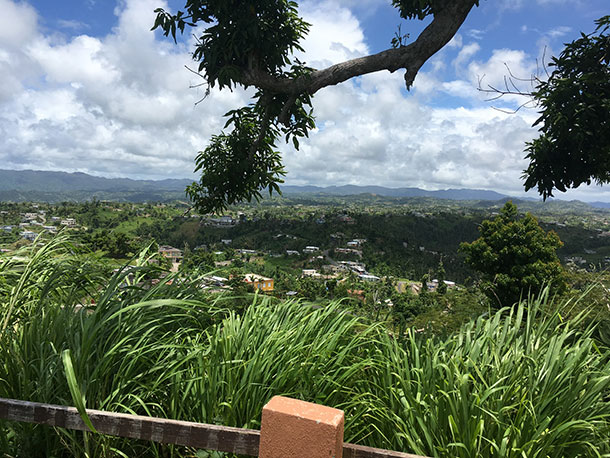
These homes in Humacao were some of the very first in Puerto Rico to feel the impacts of the Hurricane. (Photo: Bobby Bascomb)
BASCOMB: Into your house?
NIEVES: Yeah, through all the windows. Through the storm shutters, it didn’t matter. It was just coming through. And at first we were actually trying to figure out if we could dry the water and like address that. And then we also started noticing, we have all of our doors, our glass sliding doors, and we noticed that the glass was bending inward, so to try to keep it from being pushed into the house, we took all of our furniture and backed it up from the door to the wall, like in a chain. It was like, the table, and the chair, and the bookshelf - and everything supported each other all the way to the nearest column.
But that didn’t help. And it was around 4 in the morning that the skylights exploded in, and then the window exploded in as well. So there was glass flying. So at that point we actually got into the safest spot, which was a bathroom under the staircase that had no… other than the door, there was no way of getting in or out. We got in -- dog, cat, three adults, in this tiny bathroom, and just waited. And then we started seeing the water coming in from under the door. It’s just like coming in, and coming in, and we’re just like, what do we do? So we just put everything we had and basically everything that got wet we had to toss away.
And it was just, the hurricane came in. So… it was not just water, it was leaves. And then the painting from inside the walls was stripped… scraped off from the pressure. It was like a pressure washer had come into the house and just scraped… not only outside, but inside.
BASCOMB: The paint came right off your walls?
NIEVES: Mm hm.
BASCOMB: That sounds really scary.
NIEVES: Oh yeah. I mean, it was… Luis is a musician, so he was playing - my partner - he was playing the guitar. His cousin is also, you know, his entire family plays some sort of instrument, so he was playing the drums, or the percussion. So we were dealing with it by singing. And we spent the entire hurricane like that. And then once we actually got into the bathroom there was not a lot of space, so we kind of took a nap, sometime in the middle of the night, because you’re so exhausted, and there’s nothing you can do, you know, everything’s getting destroyed. And when we came out at 7 in the morning, we noticed that the, our 2,000 gallon cistern - something had come off, so the entire cistern was getting, was emptying out. And that was just at the moment when the wind was changing directions. So we never felt the calm of the storm, we were kind of… it was basically the wall of the eye, we never got the actual eye.
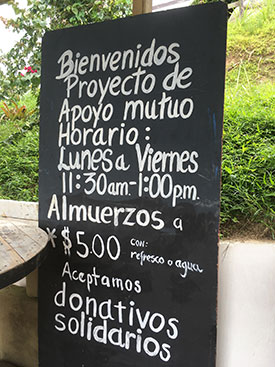
A sign advertises that the Mutual Aid Project accepts $5 “solidarity donations” for lunch Monday through Friday. (Photo: Bobby Bascomb)
So this was like, that wall of the eye just passed right through us. And we got, because of our altitude, we also got the strongest winds, and some of the storm shutters were actually pulled off from the wall. It was like, it was something so massive that you can’t quite understand it and comprehend it, when you see that something that’s designed to withstand storms didn’t, that’s when you realize, ok, we’re dealing with something that’s beyond the scales that we’re used to.
BASCOMB: So this forest right in front of us, I mean, you can see that it used to be a forest, and it still is to some degree, but there are no leaves really on the side of the trees and all of the tops are cut off at the same length, at the same height.
NIEVES: Mm hm, mhm. Yeah, so, all of these trees that you see here, they were massive. You couldn’t see beyond them. It was so thick, you couldn’t see the houses even. It looks much better eight months later, because nature is so wonderful and it can bounce back so much faster than human beings can in many ways. But that was actually one of the first things I noticed, that even before FEMA had arrived to Mariana, we were seeing the trees bouncing back. So the trees were faster in their response, than FEMA even.
BASCOMB: Yeah, it looks like just a big chainsaw went through and just cut the tops off everything and stripped the sides off the trees.
NIEVES: Yeah. It was like a bomb exploded. And it was also… if you had come here the days after, it looked just like sticks, like matchsticks, just like sticking up, everything looked grey, and it was actually one of the hardest things, because people who live here, obviously, love nature, and it’s one of the reasons why I moved back, and it was very hard to see the amount of destruction.
BASCOMB: When you came out here the day or two after the hurricane and you looked out here, how did it make you feel to see it look so different, to see the trees just denuded?
NIEVES: Well, when we walked out of the bathroom and went to one of the windows in the house, we were on the bottom part of the house… oh my god, I - Luis, actually, my partner, he started crying, because those were the trees that he grew up with. And it was just a complete feeling of… it was like all the movies that you’ve seen of Armageddon, of destruction, of the end of days, it was like - this is done. And the fact that the communication collapsed meant that also we couldn’t hear the government, but we couldn’t hear each other. All we had was the people next to us.
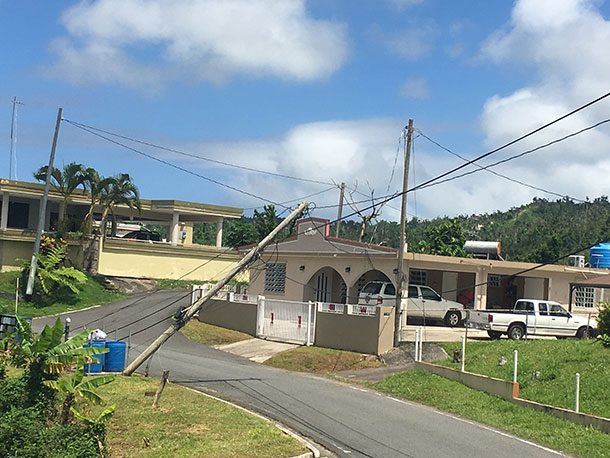
Eight months after the storm Puerto Ricans were still being injured and killed by falling trees and electrical poles. (Photo: Bobby Bascomb)
BASCOMB: In my two and a half weeks reporting in Puerto Rico I heard this same sentiment over and over again. Communities were isolated, FEMA and the government were slow to respond, so people turned to their neighbors for help. In many cases the dense forest before the hurricane had blocked their view of each other. People might not know there was a house across the street or down the way a bit, but after Maria turned the lush forest into matchsticks, neighbors could see each other for the first time and came to rely on one another for help.
NIEVES: The people in this area that are starting to understand that the government is not going to respond and save them, it’s actually going to be their neighbors -- having, you know, the machetes ready. Knowing how to disinfect a wound. That’s one of the things that they saw the most, was wounds that could have been disinfected ended up in amputations. So they had to cut so many feet off because people were in flip-flops in standing water that had infections and they just couldn’t, they didn’t have something like iodine or something that could be easily over-the-counter, anyone can have, disinfecting the wound at the right time. So, it’s that kind of education and preparedness and it’s also community organizing, to prepare for the next hurricane.
BASCOMB: Most of the residents of Humacao are older, retirees who live alone and have been without electricity since the hurricane. Christine takes me to meet one of them.
NIEVES: So, let’s go find Gloria.
BASCOMB: So, I’ll just follow you guys in my car.
NIEVES: Yeah.
[CAR SOUNDS]
BASCOMB: I follow Christine down the mountain to meet Gloria Vasquez at her house a few miles away. A downed electrical wire grazes the top of a car parked in front of her house. She’s standing on her porch watering a potted pepper plant.

Gloria Vasquez standing in her living room. (Photo: Bobby Bascomb)
BASCOMB: Buenas!
VASQUEZ: Hello, buenas!
BASCOMB: Como estás?
VASQUEZ: Bien, bien. Gloria.
BASCOMB: Ah, Gloria, mucho gusto. Bobby.
VASQUEZ: Entónces… (In English) Let me show her something I am planting.
BASCOMB: Of course.
BASCOMB: Gloria is 70 years old. She wears an oversized red t-shirt and her hair slicked back in a small ponytail. Her house sits on the side of the mountain overlooking the valley. She can see clear to the ocean some 40 miles away. Before the hurricane Gloria says she could only see the dense forest in her yard and an avocado tree taller than her house.
VASQUEZ: The tree, it was so big, tall. It feel me very, very bad. And I cry like crazy. Because I don’t think that Puerto Rico is going to be like that, you know.
BASCOMB: You didn’t think it could look like that.
VASQUEZ: No, no, no. No, I don’t think it’s going to be like that. And still I hurt. I feel, you know, about what happened to Puerto Rico.
BASCOMB: Gloria has accepted her lost trees and the broken landscape, but she’s still struggling to deal with the day to day life, living alone without electricity.
VASQUEZ: It’s hard. Sometime I sit there and I cry because the light, I need the light, you know? I don’t have no fridge, to cool my stuff, because I got diabetes and I need to put my insulin in the fridge.
BASCOMB: So what do you do?
VASQUEZ: What I do? Sometime I take it the lady in my neighborhood, Sandra, and then Sandra let me, give me a key to put them inside the refrigerator. She got a generator.
BASCOMB: So what do you do, how do you manage it at nighttime?
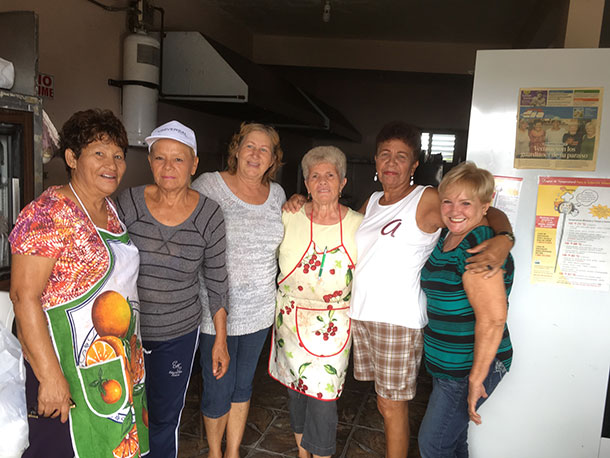
Each week a group of volunteers gathers to cook for the community. Feeding their neighbors is a type of therapy. The ladies get out of their lonely dark homes for the day and connect with friends. (Photo: Bobby Bascomb)
VASQUEZ: By 6:30 it’s starting getting darker, so I lock the gate and I lock the door and I stay inside the house, ‘cause you don’t know, you know. There’s a lot of thief here.
BASCOMB: A lot of theft.
VASQUEZ: Yeah. They ask me, oh are you there by yourself? - no, I’m not by myself. I got a husband. My husband is the police and he is working.
BASCOMB: Gloria lived most of her life in the Bronx. She moved there as a teenager with her family and worked for 50 years, mostly as a hair dresser. She saved her money all those years to retire in her native Puerto Rico where she bought this 3 bedroom cement house.
VASQUEZ: You want to come inside the house?
BASCOMB: Yeah.
VASQUEZ: This is the living room over here. This is my dining room, and the kitchen. You see, it’s dark. Let me get the flashlight.
BASCOMB: Gloria shows me around her dark house. She pauses at a crèche and a statue of the Virgin Mary given to her by her mother.
VASQUEZ: She gave me this one and this one here. They always here with me. Those are the ones that take care of me.
BASCOMB: She points out framed pictures of her grandchildren and her three sons.
VASQUEZ: That’s my baby boy here, when he graduate.
BASCOMB: How old is he now?
VASQUEZ: He’s going to be 40. And that’s me when I graduate from beauty school. Midway Beauty School in New York.
BASCOMB: In her tidy kitchen, Gloria has a few vegetables on the counter, a gas stove, a refrigerator empty but for a bottle of maple syrup, and a small red cooler on the floor where she keeps perishables like milk.
VASQUEZ: But I don’t buy no meat, because meat is getting worse quick.
BASCOMB: It goes bad quickly.
VASQUEZ: Yeah.
BASCOMB: What do you eat then?
VASQUEZ: If I want to eat something, I go into the store right there, I buy whatever I want to eat, and then I bring it. Today I’m gonna eat verdura.
BASCOMB: Vegetables.
VASQUEZ: Yeah. This is my dinner for today.
BASCOMB: Eggplant and plantain.
VASQUEZ: Eggplant, banana, and potato. That’s my dinner and my lunch, is going to be today. And this, hamonia.
BASCOMB: That’s like spam.

Maria cooks up chunks of pork for lunch at the community center in Humacao. (Photo: Bobby Bascomb)
VASQUEZ: Yeah, spam. And then I cook it and eat half, and I leave the other half for later. That’s the life here. Hard, hard. But what I gonna do?
BASCOMB: That’s the life for most of the residents in Humacao. The majority of people here are elderly, living alone, and without power. That isolation can be depressing and deadly. But since Maria hit, locals are looking to each other for solace and sustenance.
[DRIVING SOUNDS]
BASCOMB: The next day I drove the twisty road back to the mountaintop community center in Humacao. Half a dozen older women have gathered today to cook for their neighbors, as they do each week, Monday through Friday.
There’s a sign out front that indicates when they’ll be cooking and says ‘aceptamos donativos solidarios’ – ‘we accept solidarity donations’. For five dollars anyone can buy a homemade lunch of rice, beans, and meat. Maybe some fruit if one of the ladies has extra papaya or pineapple coming up at home. Today a woman, ironically named Maria, is cooking up chunks of pork.
[SIZZLING SOUNDS]
MARIA: I like to make the meat soft and nice and tender. Would you like a bite?
BASCOMB: It’s very good.
MARIA: It is, it is. Rice and beans… oh gosh we’re eating good here.
BASCOMB: Maria says coming here to feed the community is a type of therapy for her. She gets out of her lonely dark house for the day and cooks with her friends. They chat about family and argue like sisters. Life feels normal again.
This theme of working together and resilience is everywhere in post-Maria Puerto Rico.
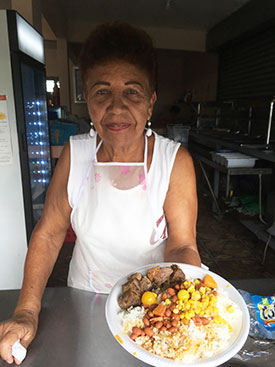
Lunch is served! For $5, anyone can buy a lunch of rice, beans, and meat. Beyond food, community members can connect with one another and feel less alone. (Photo: Bobby Bascomb)
About 9 months after the storm a local musician named Hurray for the Riff Raff produced a song in part about recovery on the island. The music video shows scenes of a hurricane-ravaged community, and tells the story of a young family trying to work through it.
[MUSIC: Hurray For The Riff Raff, “Pa'lante” on The Navigator]
SINGER: From El Barrio to Arecibo,
Pa’lante…
From Marble Hill to the ghost of Emmett Till,
Pa’lante…
BASCOMB: Pa’lante is truncated from the Spanish phrase para adelante, which literally means move forward, but Humacao community organizer Christine Nieves says it means much more than that now.
NIEVES: So, ‘pa’lante’ means we’re going to keep moving forward, we’re going to keep rising, and we’re going to keep fighting. And I think it also means, for me it’s about connecting with the root. We’ll look back at this moment in history and I think it’ll have a huge fork in the road in what it does to the Puerto Rican psyche. The conclusion at the end of this disaster that we’re still living in is that it’s us, we were the ones that could respond. We were the ones that had to and that were capable of saving lives, and it was community members that were capable of doing it. So, pa’lante. We keep building, we keep building.
[MUSIC: Hurray For The Riff Raff, “Pa'lante” on The Navigator]
BASCOMB: If there’s any silver lining to the devastation that Maria brought here it might be this: a renewed sense of community, Puerto Rican pride, and resiliency that people hope will keep them moving forward to rebuild and meet the next challenge together.
[MUSIC: Hurray For The Riff Raff, “Pa'lante” on The Navigator]
BASCOMB: So Pa’alante, what does that mean to you Adnally?
MARICHAL: It actually means Para Alante, which means moving forward is kind of the direct translation in Spanish. Which has kind of become kind of like a rallying call, I'd say for Puerto Ricans after the storm, and maybe even before the storm, it does actually give me a sense of hope, like we are all in this together. And we're all trying to move forward together as best as we can.
BASCOMB: Do you think that there's more sense of that now after the hurricane than there was before the storm? I mean, it seems like I, you know, I did on many stories and different aspects of life there. In almost all of them, I got the sense that people were sort of working through it together, because they had to look to each other for help.
MARICHAL: Definitely. I mean, I can't speak for all communities, but communities that I've worked with, and taking part in there is definitely a strong sense of moving through this together. And knowing that the problems that Puerto Rico is facing after the storm, and even before the storm, or not anything that can be resolved by one person, or even a few people big changes like this can only be done if everyone comes together. And that speaks to, you know, anything from helping someone fix their farm up to much bigger political change. So I think that there definitely is a sense of the community having to come together after something like this.
BASCOMB: And so the population of Puerto Rico is about 3 million people, but many hundreds of thousands of people left as a result of this storm. I mean, that can be easy.
MARICHAL: No, definitely not. And it feels like pretty much everyone who left didn't do it, because they necessarily wanted to, you know, no one wants to leave their family behind, or their schools behind or their community behind. Oftentimes, it is out of economic necessity. So it's, it's a really hard thing to have to go through a storm, and maybe lose a lot. And then in addition, lose your whole way of life.
BASCOMB: I get the impression that the people that did leave are probably younger, you know, still in the workforce and looking for more opportunities.
MARICHAL: That is definitely the case. And I think, you know, at different points in Puerto Rico's history, there have been points of this back and forth stateside to Puerto Rico because of economic conditions. And I think that this is another one of those big times where there's a lot of people leaving, and maybe not really coming back. And I feel like what's interesting about this time is that it's not just people that are economically vulnerable, it's also people that might have a college education, or might have a more white collar job, because even those jobs are disappearing here. And those opportunities are disappearing here. So it's a lot of different types of people are leaving the island, which I think is different than other times,
BASCOMB: Then, of course, that leaves you know, as I talked about in this story, I mean, Humacao most of the people that live there, older, retired people, I mean, those are the people that aren't going to just pick up and leave their home anymore. You know, no matter how bad it gets really, right. It was really fun for me actually, to visit the community center and spend the day with these older ladies who just, you know, you can tell they just like to come and argue with each other and, you know, gossip, and tell stories. It was really fun.
MARICHAL: For sure. And actually, that makes me like, think about what we were talking about earlier. But is there a stronger sense of community here on the island versus stateside, and it actually just reminded me that even though there is sometimes a little bit of isolation with people living here and living there, and things only being accessible by car, I do feel like one thing that is kind of unique about Puerto Rico, or maybe Puerto Ricans in general, are that everyone is very gregarious, like everyone wants to chat and talk and see how you're doing complete strangers. Like, pretty much every time I'm in the supermarket People want to chat, want to see what's going on in a way that I definitely did not encounter when I lived in New York City for most of my adult life. So in that sense, there definitely is a feeling of community that I haven't really experienced in a lot of other places.
BASCOMB: Yeah, I actually experienced that there too. And I don't look like I'm going to speak Spanish necessarily. I do badly. But still, you know, one thing I really loved actually, is, no matter who you are, if you're eating in a public area, like a cafe outside or something, if somebody walks by they always say buen provecho, like enjoy your meal, bon appetit. You know, right, which is such a sweet part of the culture, I think.
MARICHAL: I totally agree. And it's one of those things that I really appreciate it. But I think everyone like it's one of those things that when I speak to native Puerto Rican from here, they're like, wait a second, you don't, you don't have that in the States? Like that's not a thing? And they don't really get it, they don't understand that we're not quite as polite or sweet in public with each other. Here, it's just second nature to say that to everyone. I like even if you go to the post office, for instance. And you know, there's a huge line, everyone that comes in the door, says good afternoon to the entire room, and is really excited about it. And everyone says good afternoon to them too. So it's like little things like that little cultural thing is that definitely feel different than the way I grew up in in Connecticut or any experience I ever had in New York.
BASCOMB: Yeah, gosh, I love that image. Just a whole post office full of people saying good afternoon, to the person that walks in.
MARICHAL: Yeah, it's really nice.
BASCOMB: Yeah, that's great. Alright, Adnelly, well thanks for chatting. And next time, I think we're going to talk about the farming story I did, which is actually how I met you.
MARICHAL: Yeah, that sounds great.
Back to Our 5-part series: Hurricane Maria in Puerto Rico
Living on Earth wants to hear from you!
Living on Earth
62 Calef Highway, Suite 212
Lee, NH 03861
Telephone: 617-287-4121
E-mail: comments@loe.org
Newsletter [Click here]
Donate to Living on Earth!
Living on Earth is an independent media program and relies entirely on contributions from listeners and institutions supporting public service. Please donate now to preserve an independent environmental voice.
NewsletterLiving on Earth offers a weekly delivery of the show's rundown to your mailbox. Sign up for our newsletter today!
 Sailors For The Sea: Be the change you want to sea.
Sailors For The Sea: Be the change you want to sea.
 The Grantham Foundation for the Protection of the Environment: Committed to protecting and improving the health of the global environment.
The Grantham Foundation for the Protection of the Environment: Committed to protecting and improving the health of the global environment.
 Contribute to Living on Earth and receive, as our gift to you, an archival print of one of Mark Seth Lender's extraordinary wildlife photographs. Follow the link to see Mark's current collection of photographs.
Contribute to Living on Earth and receive, as our gift to you, an archival print of one of Mark Seth Lender's extraordinary wildlife photographs. Follow the link to see Mark's current collection of photographs.
 Buy a signed copy of Mark Seth Lender's book Smeagull the Seagull & support Living on Earth
Buy a signed copy of Mark Seth Lender's book Smeagull the Seagull & support Living on Earth

